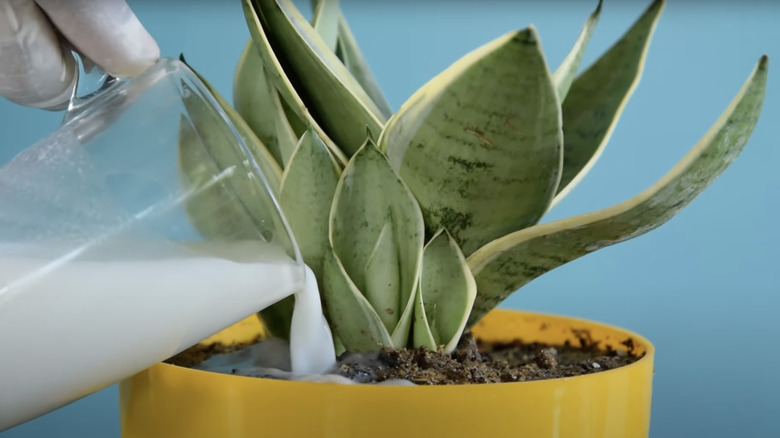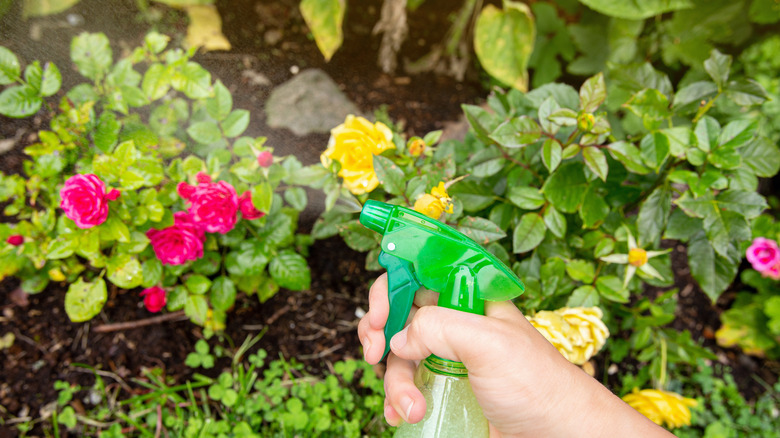Should You Try Watering Your Plants With Milk? Here's What To Know
Have you ever heard of milking your plants? By milking your plants, we obviously mean watering your plants with milk, if that makes sense. Either way, this just sounds weird and needs plenty of explaining before you and your plants get in cahoots with milk. So, should you try watering your plants with milk? The short answer is yes, and here is what to know before showering your plants with it.
Milk is highly concentrated with calcium, protein, vitamins, and sugars, all of which nourish your plant to become big and strong — just like our parents told us at the table. Although, for plants, milk can be fresh, expired, evaporated, and even powdered. Now, whenever you open your fridge and come across an expired milk carton, it won't be entirely bad news. It just means your plants will be able to enjoy it. Regardless of your fashion of milk, it ultimately serves as a unique fertilizer that also remedies many garden issues, including calcium deficiencies, rot, viruses, and mildew.
Before you run to your kitchen to grab the milk jug, it's crucial to understand that milk should not replace water entirely. While milk does have beneficial nutrients for plants, it can't quench their thirst like water does. Moreover, like anything in life, too much of a good thing can be harmful.
The right and wrong way to use milk as plant fertilizer
Using milk as a fertilizer should be seen as a supplement, not a primary source of hydration. A 100% milk regimen can lead to issues like mold growth due to its sugar content, or a bad smell as the milk decomposes. The recommended dilution ratio is usually half milk and half water. This applies to any type of milk you are using for leaves or soil.
For gardening enthusiasts with a sizeable patch to care for, don't fret, you would be surprised how far your milk can go. A quart nicely covers a 20 by 20-foot garden, while 5 gallons can be enough for an entire acre. Mind you, once the milk's in the mix, it's best to keep the chemical fertilizers and pesticides away. They're like uninvited guests, upsetting the beneficial bacteria in milk, which are there to boost plant growth. If you encounter a slightly off smell post-milk application, don't worry; it's only temporary.
If you only have a few small plants, use a spray bottle. This will keep you from potentially over-milking (overwatering). Spray onto the soil as needed and then onto foliage. Be sure to pay attention to your leaves and make sure that the solution has been properly absorbed after a reasonable time. If it hasn't, wipe it down and remove it as this could lead to fungal problems in some plants.
An unorthodox fertilizer worth considering
Not all plants react the same to milk; some species can be particularly sensitive to it. Therefore, it's always best to research how your specific plants might behave, along with some general care tips. Moreover, you can rest assured these plants love it: angel wing begonias, jade plants, English ivy, African violets, and kalanchoe. However, try to avoid skim milk as it can cause problems like rot and leaf spotting on your plants.
"Milking" your plants, or watering them with milk, can serve as an effective alternative in gardening. Utilizing milk's nutrients can lead to healthier, more robust plants. However, remember it isn't a substitute for water. The key is a balanced approach, with a fifty-fifty mix of the two.
Interestingly, some gardeners are now experimenting with dairy byproducts like yogurt and whey cheese, further expanding the horizons of this milky method. Thus, "milking" plants, when done correctly, could be a meaningful addition to sustainable gardening practices. So, the next time you find an old carton of milk in your fridge, don't be too quick to pour it down the drain. Consider feeding it to your plants instead. They might just thank you for it.


